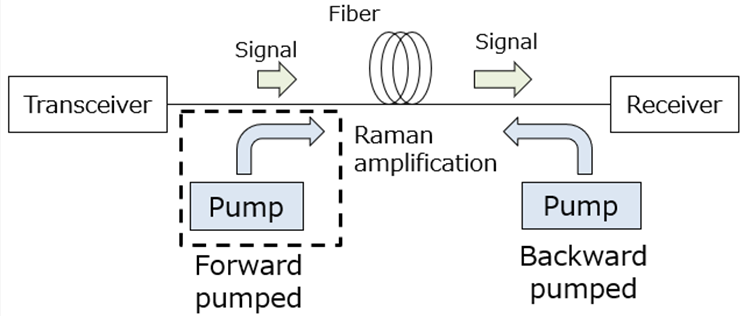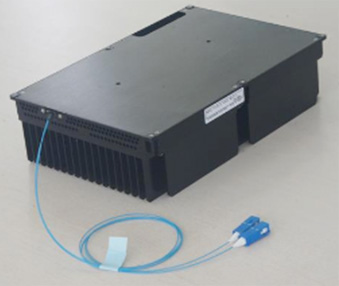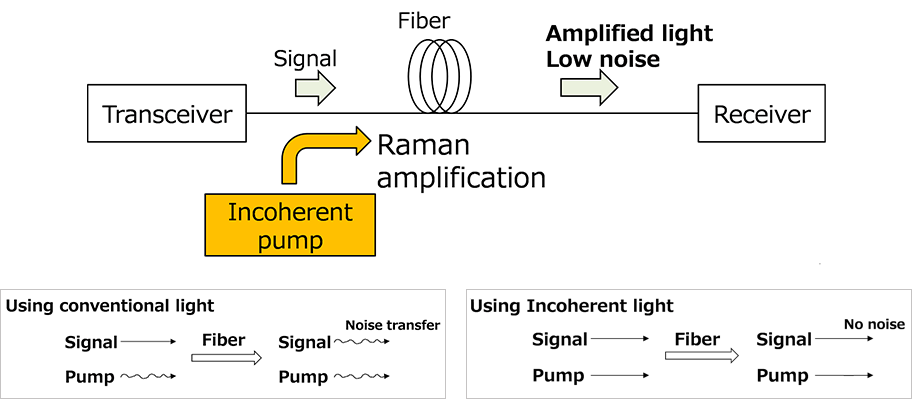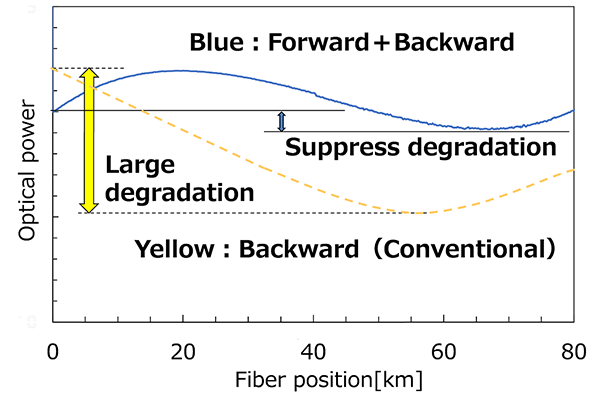Development of the Forward Raman Unit for low noise signal transmission
- Incoherent light generated by optical semiconductors enable longer distance and higher signal transmission -
- Developed a Forward Raman Unit based on optical semiconductors for forward Raman amplification enables improved low noise signal propagating through the link. Shipping samples from July 2023
- By using incoherent light as pump light, high quality signal transmission is obtained even in forward Raman amplification
- Furukawa Electric will continue to develop higher output power of incoherent light source that will further push noise improvement
Furukawa Electric Co., Ltd. (Head office: 2-6-4 Otemachi, Chiyoda-ku, Tokyo; President: Keiichi Kobayashi) developed Forward Raman Units that enable longer distance and higher quality signal transmission with improved noise characteristics compared to conventional transmission systems. We will begin shipping samples from July 2023 with manufacturing commencing thereafter.
Background
Raman amplification(note 1) is a core technology in optical fiber communications. Backward Raman amplification, which amplifies optical signals from the receiving side, is applied in current optical fiber communications systems. The pump light propagates in the opposite direction to the signal light in backward Raman amplification. Although the impact of noise caused by the pump light is averaged and reduced, there is room to improve the transmission characteristics of the signal light propagating through the optical fiber. On the other hand, with forward Raman amplification, the pump light propagates in the same direction as the signal light. The ability to amplify the output power of the signal light from the transmission input point reduces signal light attenuation. Therefore, it is expected that the benefits of Raman amplification can be maximized. However, the impact of pump light noise needed to be addressed (Fig. 1).

Details
The newly developed Forward Raman Unit uses low noise incoherent light as the pump source. Because our incoherent light has wide bandwidth, it suppresses the interaction between the pump light source and signal light. As a result, it is possible to reduce the impact of noise in the Forward Raman Unit and bring higher quality signal transmission (Fig. 2).


Also, compared to the conventional backward Raman amplification, signal light attenuation while propagating through a fiber is decreased when adding forward Raman amplification. Therefore, it is possible to maintain high signal quality during transmission (Fig. 3). As a result, transmission distance is extended while also improving the quality of the signal over the same distance. This new Forward Raman Unit will contribute to solving the issue of reduced transmission distance resulting from faster transmission speeds in recent years.

In addition to these developments, we are working to increase output power of the Forward Raman Unit by amplifying the incoherent light using our unique Second Raman method(note 2) technology. We will further improve the amplification characteristics by increasing the output power of the optical semiconductor incoherent light sources.
The new Forward Raman Unit will be exhibited at OFC 2023 scheduled to be held on March 7-9, 2023 in San Diego (at the OFS Fitel, LLC booth; Booth number 3229).
OFC 2023
(note 1)Raman amplification: When pump light is input into an optical fiber, stimulated Raman scattering occurs in the wavelength region that is 100nm longer than the wavelength of the pump light. If signal light propagates with the pump light, it is amplified through stimulated Raman scattering. As a result, this effect can be used as an optical amplification. Such amplification has excellent characteristics, including wide amplification bandwidth and amplification at any bandwidth, and it is widely used today.
(note 2)Secondary Raman pumping method: Method that uses a coherent light source to amplify the incoherent light source while propagating through an optical fiber. As a result of Raman amplification, the coherent light source amplifies the incoherent light source in the transmission fiber, making it possible to provide secondary Raman amplification to the signal light while maintaining low noise.
Furukawa Electric Group’s efforts towards the SDGs
Based on the “Sustainable Development Goals (SDGs)” adopted by the United Nations, Furukawa Electric Group has formulated the “Furukawa Electric Group Vision 2030” which sets the year 2030 as its target and is advancing efforts with the aim to “Build a sustainable world and make people’s life safe, peaceful and rewarding, Furukawa Electric Group will create solutions for the new generation of global infrastructure combining information, energy and mobility.” Toward the achievement of our Vision 2030, we will take open, agile, and innovative approaches to promote ESG management that aims to increase corporate value over the medium to long term and will contribute to the achievement of the SDGs.







 Share
Share Tweet
Tweet Share
Share